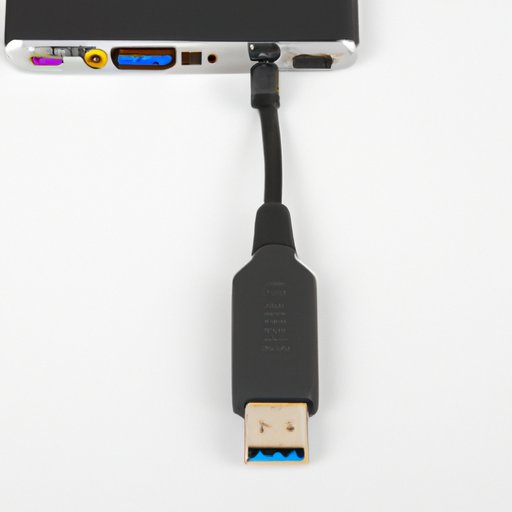Introduction
Connecting a laptop to a TV is a great way to enjoy content from your laptop on a large screen. There are several ways to do this, including using an HDMI cable, a DisplayPort connection, a VGA connection, a wireless connection, or a USB connection. In this article, we’ll explore each of these connection types in detail and provide step-by-step instructions for setting up the connection.
HDMI Connection
HDMI (High Definition Multimedia Interface) is a connection type that is widely used for connecting devices such as laptops, TVs, Blu-ray players, and more. It is capable of carrying both audio and video signals, so it is ideal for connecting laptops to TVs. The benefits of using an HDMI connection include its high resolution, which allows for crisp and clear images, as well as its ability to carry both audio and video signals. Here are the steps for setting up an HDMI connection:
- First, make sure that both your laptop and TV have an available HDMI port.
- Next, insert one end of the HDMI cable into the HDMI port on your laptop.
- Then, insert the other end of the HDMI cable into the HDMI port on your TV.
- Finally, select the HDMI input on your TV.
DisplayPort Connection
DisplayPort is another connection type that is commonly used for connecting laptops to TVs. Like HDMI, it is capable of carrying both audio and video signals, and it also supports higher resolutions than HDMI. The benefits of using a DisplayPort connection include its support for higher resolutions and its ability to daisy chain multiple monitors together. Here are the steps for setting up a DisplayPort connection:
- First, make sure that both your laptop and TV have an available DisplayPort port.
- Next, insert one end of the DisplayPort cable into the DisplayPort port on your laptop.
- Then, insert the other end of the DisplayPort cable into the DisplayPort port on your TV.
- Finally, select the DisplayPort input on your TV.
VGA Connection
VGA (Video Graphics Array) is an older connection type that is still found on some laptops and TVs. It is capable of carrying only video signals, so if you are connecting a laptop to a TV with a VGA connection, you will need to use a separate audio cable for sound. The benefits of using a VGA connection include its wide availability and its low cost. Here are the steps for setting up a VGA connection:
- First, make sure that both your laptop and TV have an available VGA port.
- Next, insert one end of the VGA cable into the VGA port on your laptop.
- Then, insert the other end of the VGA cable into the VGA port on your TV.
- Finally, select the VGA input on your TV.
Wireless Connection
Wireless connections are becoming increasingly popular for connecting laptops to TVs. These connections allow you to stream content from your laptop to your TV without having to worry about cables or adapters. The benefits of using a wireless connection include its flexibility and ease of use. Here are the steps for setting up a wireless connection:
- First, make sure that both your laptop and TV support the same wireless standard.
- Next, connect your laptop and TV to the same wireless network.
- Then, use the TV’s remote control to select the “Screen Mirroring” option.
- Finally, follow the on-screen instructions to complete the connection.
USB Connection
USB (Universal Serial Bus) is a connection type that is often used for connecting peripherals such as mice and keyboards to laptops. It is also possible to use a USB connection to connect a laptop to a TV. The benefits of using a USB connection include its ease of use and its ability to carry both audio and video signals. Here are the steps for setting up a USB connection:
- First, make sure that both your laptop and TV have an available USB port.
- Next, insert one end of the USB cable into the USB port on your laptop.
- Then, insert the other end of the USB cable into the USB port on your TV.
- Finally, select the USB input on your TV.
Conclusion
Connecting a laptop to a TV is a great way to enjoy content from your laptop on a large screen. There are several ways to do this, including using an HDMI cable, a DisplayPort connection, a VGA connection, a wireless connection, or a USB connection. Each of these connection types has its own advantages and disadvantages, so it is important to consider your needs when deciding which connection type is right for you. If you experience any issues with your connection, try troubleshooting the issue by checking the cables, restarting the device, or checking for software updates.


